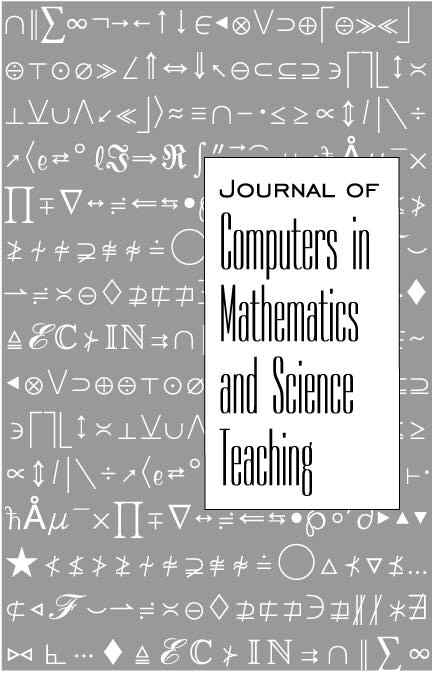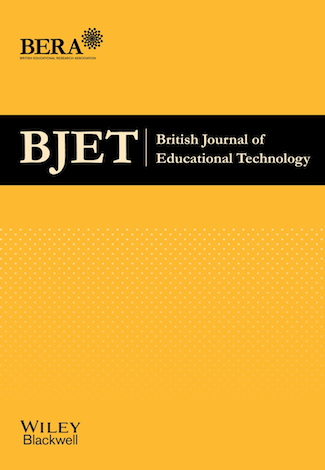Browsing by Subject: Classrooms
-
Word Processing and Writing in Elementary Classrooms: A Critical Review of Related Literature
Marilyn Cochran-Smith
Review of Educational Research Vol. 61, No. 1 (1991) pp. 107–55
Literature on word processing (WP) and writing in elementary classrooms is reviewed. Five propositions are constructed to provide a schema for understanding what is known and needs to be learned... More
pp. 107-55
-
Educational Technology and the Restructuring Movement: Lessons from Research on Computers in Classrooms
Diane Kell
()
This paper presents findings from a recently completed study of the use of computers in primary classrooms as one source of evidence concerning the role technology can play in school restructuring ... More
-
An Observational Study of Social Behavior in Microcomputer Classrooms
Shirley C. Feldmann
Computers in Human Behavior Vol. 7, No. 1 (1991) pp. 45–55
This study examined the effects of five variables--student grouping at the computer, keyboarding status, academic discipline, student gender, and gender of partner--on student social behavior, both... More
pp. 45-55
-
The Evolution of Teachers' Instructional Beliefs and Practices in High-Access-to-Technology Classrooms
David C. Dwyer
()
Beginning in 1985, Apple Computer, Inc., and several school districts began a collaboration to examine the impact of computer saturation on instruction and learning in K-12 classrooms. The initial ... More
-
Changes in Teachers' Beliefs and Practices in Technology-Rich Classrooms
David C. Dwyer
Educational Leadership Vol. 48, No. 8 (1991) pp. 45–52
The Apple Classrooms of Tomorrow (ACOT) project is a flexible consortium of researchers, educators, students, and parents who have worked collaboratively to create and study innovative learning... More
pp. 45-52
-
Linking Classrooms of the Future through Interactive Telecommunications Network
Ponney G. Cisco
()
This document describes an interactive television (ITV) distance education network designed to service rural schools. Phase one of the network involved the installation of over 14 miles of fiber... More
-
Creating Computer Environments for Gifted Learners in Primary Classrooms
Shelley B. Wepner
Journal of Reading, Writing, and Learning Disabilities International Vol. 4, No. 3 (1989) pp. 155–70
The article discusses how computers can be used for reading/language arts instruction for gifted learners in primary classrooms. Described are three specific computer modes--tool (assistance),... More
pp. 155-70
-
Designing a Microcomputer Classroom for Teaching Composition
Stephen A. Bernhardt
Computers and Composition Vol. 7, No. 1 (1989) pp. 93–110
Discusses the following issues associated with designing ideal university microcomputer classrooms: (1) campus vs. departmental classrooms; (2) finding space; (3) furnishings; (4) classroom layout;... More
pp. 93-110
-
Microcomputers in Classrooms: Educational Technology or Social Practice?
Hugh Mehan
Adult Education Quarterly Vol. 20, No. 1 (1989) pp. 4–22
Studies the use of microcomputers in four elementary school classrooms and their effect on classroom organization, teacher-student relations, and curriculum. Concludes that how people use a... More
pp. 4-22
-

A Workshop on Using Software in Mathematics Classrooms
J Richard Morris & Barbara D. Bass
Journal of Computers in Mathematics and Science Teaching Vol. 8, No. 2 (1989) pp. 20–21
Describes a summer graduate level course at Virginia Commonwealth University for mathematics teachers. Notes that the purpose of the course was to allow the teachers access to software usable in... More
pp. 20-21
-
Microcomputers in Special Education Classrooms: Themes from Research and Implications for Practice
Joan Thormann
Computers in the Schools Vol. 3, No. 3 (1986) pp. 97–109
Discusses the findings of four studies that examined the use of microcomputers in special education classrooms. Surveys, interviews, and observations were used to discover software currently in use... More
pp. 97-109
-
Computer-Assisted Instuctional Methods: A Factorial Study within Mathematics Disadvantaged Classrooms
Zemira R. Mevarech
Journal of Economic Education Vol. 54, No. 1 (1985) pp. 22–27
This study reported the contribution of computer-assisted instruction (CAI) employed in traditional and individualized classrooms to cognitive and personal growth of third-grade disadvantaged... More
pp. 22-27
-

Facilitating in a demanding environment: Experiences of teaching in virtual classrooms using web conferencing
Sarah Cornelius
British Journal of Educational Technology Vol. 45, No. 2 (Mar 10, 2014) pp. 260–271
“How to” guides and software training resources support the development of the skills and confidence needed to teach in virtual classrooms using web-conferencing software. However, these sources do... More
pp. 260-271
-
A study of the factors that influenced K-6 teachers to implement computer usage in their classrooms
Patricia Anne Boyd, University of La Verne, United States
(1999) pp. 1–185
Purpose . This study identified factors that influenced K–6 teachers to implement computer usage in their classrooms. Five barrier factors previously identified by the U.S. Office... Morepp. 1-185
-
Technology-enhanced multimedia instruction in foreign language classrooms: A mixed methods study
Olha Ketsman, The University of Nebraska - Lincoln, United States
(2012) pp. 1–145
Technology-enhanced multimedia instruction in grades 6 through 12 foreign language classrooms was the focus of this study. The study's findings fill a gap in the literature through the report of... More
pp. 1-145
-
The relationship of teaching style and computer use in classrooms of northeast Louisiana
Peggy Rhymes Wheelis, University of Louisiana at Monroe, United States
(1999) pp. 1–101
pp. 1-101
-
Integrating student laptops into classrooms: A teacher-led PLC journey
Glen Coleman, Drew University, United States
(2012) pp. 1–200
This ethnographic study was conducted by a high-school teacher (participant-observer) who studied the cultural and pedagogical challenges that he and his colleagues encountered as they transitioned... More
pp. 1-200
-
Stories of digital lives: Teacher-student relationships in secondary classrooms and digital spaces
Shanedra Dilese Nowell, Oklahoma State University, United States
(2012) pp. 1–191
This qualitative teacher research study employed narrative inquiry in order to gain greater understanding of how secondary teachers and students made connections using digital online media. ... More
pp. 1-191
-
Elementary teachers' beliefs regarding the use of the Internet in K-5 classrooms and the impact on their teaching practices
Joyce Monica Geranis, The University of Arizona, United States
(1999) pp. 1–211
This is a study to examine and describe of elementary teachers’ beliefs regarding the use of the Internet in K–5 classrooms and the impact of the use of the Internet on their teaching... More pp. 1-211
-
A quantitative examination of factors that impact technology integration in urban public secondary mathematics classrooms
Phyllis Harvey-Buschel, Bowie State University, United States
(2009) pp. 1–134
pp. 1-134
